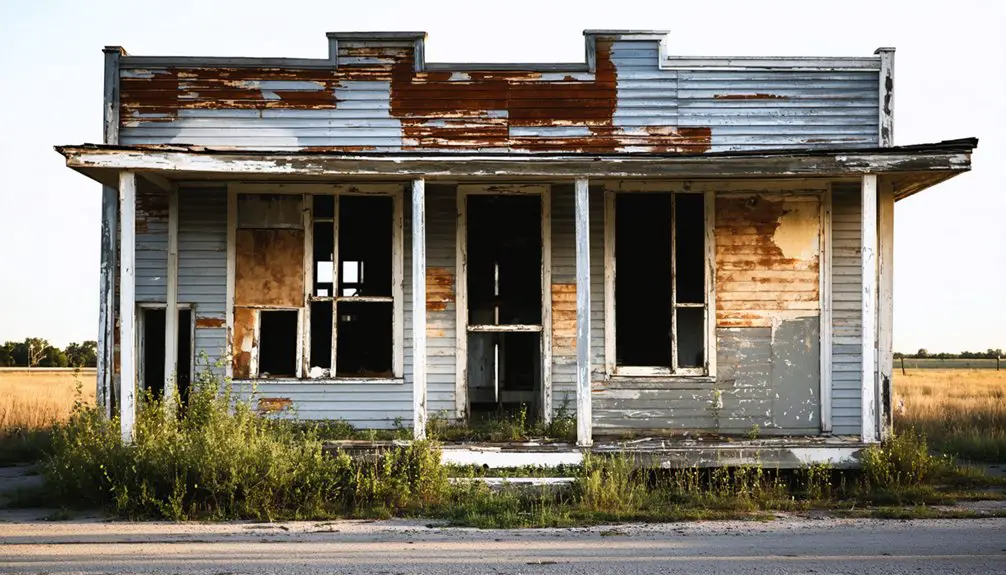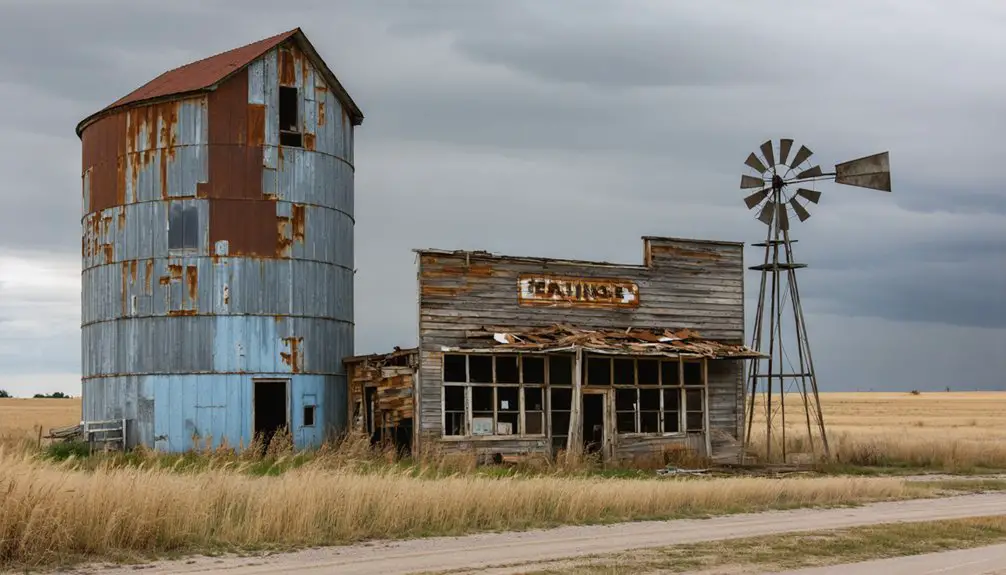You’ll find Woodville’s fascinating story beneath Lake Texoma‘s waters in Oklahoma. Originally established as Harney in 1881, then renamed Woodville in 1888, this frontier town thrived with cotton trade and lumber production until 1944. When the Denison Dam project created Lake Texoma, residents relocated two miles north to New Woodville, leaving their original town to sink beneath the waters. Local legends tell of mysterious lights and unexplained phenomena around the submerged settlement’s resting place.
Key Takeaways
- Woodville, Oklahoma now lies beneath Lake Texoma after being submerged during the 1939 Denison Dam project construction.
- The original town site was completely relocated in 1900 to align with the St. Louis-San Francisco Railway, creating New Woodville.
- Local fishermen report mysterious lights, unexplained sounds, and shadowy figures near the submerged town site beneath Lake Texoma.
- The town’s history includes visits from outlaws like Bonnie and Clyde, who attended local chicken fights without causing trouble.
- New Woodville continues to exist with approximately 60 residents, while the original ghost town remains underwater, occasionally exposed during droughts.
The Birth of a Railroad Town
While many frontier towns emerged organically, Woodville’s birth followed a deliberate path shaped by railroad expansion.
You’ll find its roots in 1881 when it was established as Harney in Indian Territory, later renamed Woodville in 1888 to honor settler L.L. Wood.
The real turning point came in 1900 when the St. Louis-San Francisco Railway planned its route through the region. Rather than risk isolation, the town made a bold move – relocating entirely to align with the Frisco line.
Facing obsolescence, an entire frontier town uprooted itself in 1900, chasing prosperity along the new railway’s steel rails.
The original settlement faced severe challenges as devastating floods repeatedly struck between 1881 and 1888.
Town planner Alfred B. Beard orchestrated this strategic shift, and the railroad impact was immediate.
The new Woodville quickly developed into a bustling hub with newspapers, grain elevators, and cotton gins. The town’s first business, Kid Morton store, opened in 1884 and became a central part of the community.
From Harney to Woodville: A Name’s Evolution
The town’s early identity took shape through a series of name changes rooted in Native American heritage. You’ll find the original name, Harney, honored Sison Harney, a full-blood Chickasaw woman, when the settlement was established on November 8, 1881. This Harney heritage reflected the area’s strong Native American connections, complete with the town’s first post office.
The Woodville transformation came in 1888 after a devastating Red River flood forced residents to relocate north. On July 9, they officially renamed the town Woodville, after Judge Laban Lipscomb Wood.
While you might wonder about abandoning the Native American name, the change represented the community’s fresh start and evolving priorities. The post office continued operating seamlessly under its new identity as Woodville grew through the 1890s.
Life in Early 20th Century Woodville
As Woodville entered the twentieth century, you’d find a bustling frontier town transformed by cotton trade, lumber production, and the arrival of modern amenities.
The economic growth was evident in the brick buildings rising downtown, including a distinctive two-story bank and one of Indian Territory’s largest sawmills. Local merchants like J.L. Coffee and W.T. Christian drove commerce while the 1885 cotton gin revolutionized processing. A public well at Broadway and Main Street served as the town’s primary water source.
The social dynamics reflected both progress and challenges. You’d see a sophisticated three-story brick school built in 1908, active fraternal organizations, and several newspapers serving a literate population.
Yet law enforcement, led by figures like Sheriff Christian, grappled with bootlegging and violent feuds. By 1907, the sight of the town’s first automobile signaled Woodville’s steady march toward modernization.
The Denison Dam Project and Its Impact
Launched in August 1939, the massive Denison Dam project forever changed Woodville’s landscape and destiny.
You’d have seen an unprecedented scale of construction activity as crews moved 18.8 million cubic yards of earth to build what was then the world’s largest rolled-earth fill dam. The project even employed German POWs from Rommel’s Afrika Korps, who earned $1.50 per day clearing trees and working on drainage. The dam generates 250,000 megawatt hours of electricity each year. The official dedication ceremony featured Congressman Sam Rayburn as the principal speaker.
The dam’s completion in 1944 brought significant economic benefits to the region through flood control and hydroelectric power generation.
Denison Dam revolutionized the region’s economy, harnessing water’s power for electricity while protecting communities from devastating floods.
The creation of Lake Texoma, with its nearly 6 million acre-feet capacity, transformed the area into a recreational haven.
Today, you’ll find 47 recreational areas, two state parks, and 80,000 acres of public hunting land where Woodville once stood.
Beneath Lake Texoma’s Waters
Once bustling with life, original Woodville now rests beneath Lake Texoma’s waters, submerged when the Denison Dam project flooded the area in 1943-1944.
Today, you’ll find a submerged history that includes not just the town’s remains, but also significant archaeological treasures from ancient Native American settlements at the confluence of the Washita and Red Rivers. The project was initially championed by Sam Rayburn’s vision to provide flood control in the 1930s.
- Foundation stones and storm cellars emerge during drought conditions, offering glimpses of lost communities
- Ancient potsherds, stone tools, and trade beads lie scattered beneath the waters
- The “Henrietta Focus” cultural intersection now sleeps under 93,080 acres of water
- Four ghost towns total rest at the bottom of Lake Texoma
- During severe droughts, like in 2013, you can walk where Woodville’s 300 residents once lived their daily lives
Like nearby Aylesworth, residents faced insufficient compensation when forced to relocate, causing economic hardship for many displaced families.
New Woodville’s Emergence
When the St. Louis and San Francisco Railway bypassed original Woodville in 1900, you’d have witnessed a remarkable town relocation orchestrated by experienced planner Alfred B. Beard. The railway’s economic impact transformed the settlement, spurring growth that included three newspapers, nine brick buildings, and a prominent two-story bank.
The town’s resilience was tested again in the early 1940s when Lake Texoma‘s creation forced another move. Despite these economic challenges, about 50 determined residents relocated two miles north, establishing today’s New Woodville.
They physically moved buildings, homes, and even the cemetery to higher ground. While the original town site now rests beneath Lake Texoma’s waters, occasionally visible during low water levels, New Woodville persists with roughly 60 residents as of 2020.
Historical Sites and Archaeological Discoveries

The confluence of the Washita and Red Rivers near Woodville held immense archaeological significance before Lake Texoma’s waters submerged the area in 1944.
You’ll find evidence of this rich heritage through archaeological discoveries that revealed the region’s importance as a crossroads of ancient trade routes. The area’s burial grounds, dating back to 1820, tell stories of early Indian Territory settlements that you can’t access today due to flooding. Similar to the Folsom projectile points found at archaeological sites across Oklahoma, artifacts discovered near Woodville help piece together the region’s prehistoric human activity. Many Native American gravesites were marked with stones in the Buncombe Creek development area before being submerged.
- Surface findings included potsherds, stone tools, and trade beads indicating long-term habitation
- Over 40 cemeteries existed in the area before Lake Texoma’s creation
- The “Henrietta Focus” helped archaeologists understand connections between southwestern and southeastern tribes
- Drought periods sometimes expose buried remnants of the town and grave markers
- Sacred burial sites remain underwater, though some headstones were relocated
Tales and Legends of Old Woodville
Deep beneath Lake Texoma‘s waters, legends of old Woodville continue to ripple through local folklore, particularly stories about notorious visitors like Bonnie and Clyde, who frequented the town’s chicken fights and camped at Washita Point.
You’ll hear tales of legendary outlaws mingling freely with townspeople during Woodville’s heyday, rarely causing trouble despite their infamous reputations. Like many abandoned towns in Oklahoma, Woodville faced a similar fate to Tar Creek communities that eventually became deserted.
Today, ghost stories abound as fishermen report mysterious lights, unexplained sounds, and shadowy figures near the submerged town site. Local lore suggests supernatural activity intensifies during certain hours, with witnesses describing cold spots, whispering voices, and electromagnetic anomalies above the lake.
Eerie phenomena haunt Lake Texoma’s depths, where fishermen encounter ghostly lights and whispers from the drowned town below.
The town’s tragic submersion during the Denison Dam construction has spawned countless narratives of spirits trapped beneath the waters, their presence marked by strange fog formations and inexplicable underwater movements.
Frequently Asked Questions
What Happened to the Original Town Records After Woodville Was Submerged?
You’ll find it’s uncertain what became of the lost documents, though common historical preservation practices suggest they may have transferred to Madill City Library or Marshall County archives.
Are There Any Surviving Photographs of the Original Woodville Buildings?
Through extensive archival research, you won’t find publicly accessible photographs of the original buildings. Historic preservation efforts haven’t uncovered verified images, though some may exist in private collections or undiscovered archives.
Did Any Original Woodville Residents Receive Compensation for Relocating?
You’ll find no clear historical records confirming specific compensation, though standard relocation assistance policies suggest residents would’ve been eligible for government payments if displaced by infrastructure projects.
Can Scuba Divers Explore the Remains of Old Woodville Today?
Through murky depths with scuba equipment, you can explore the underwater remains when lake levels permit, but you’ll need proper permissions and gear for safe underwater exploration of Lake Texoma’s hidden ghost.
Which Families From Original Woodville Still Live in New Woodville?
You’ll find limited records detailing exact Woodville descendants today. While some original family connections continue in New Woodville’s small population of 18 families, specific names aren’t publicly documented or confirmed.
References
- https://en.wikipedia.org/wiki/List_of_ghost_towns_in_Oklahoma
- https://en.wikipedia.org/wiki/New_Woodville
- https://cedarbayoumarina.com/four-ghost-towns-under-lake-texoma/
- https://www.redriverhistorian.com/post/lost-lake-texoma-woodville-aylesworth-archaeology
- https://www.madillrecord.net/news/marshall-county-history-beneath-waters
- https://www.madillrecord.net/news/marshall-county-history-new-old-woodville-pt-2
- https://www.madillrecord.net/news/marshall-county-history-new-old-woodville-part-1
- https://kids.kiddle.co/New_Woodville
- https://www.okgenweb.net/~okmarsha/history.html
- https://www.nps.gov/articles/000/harney-re-examined-part-ii-harney-s-treatment-of-native-americans.htm



